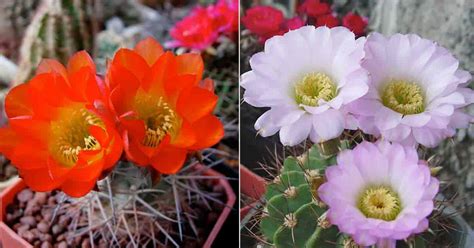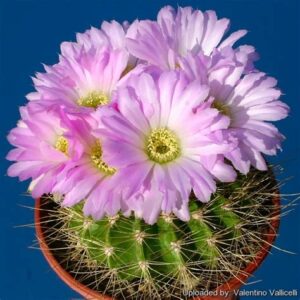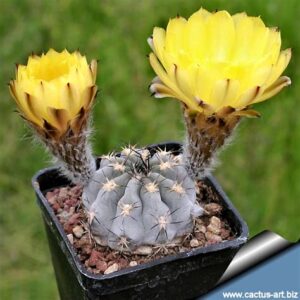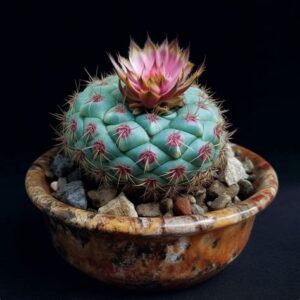Acanthocalycium glaucum v. rubriflora is an extraordinary specimen cherished by enthusiasts and hobbyists alike. Known for its striking structure and vibrant colors, this species presents unique challenges and rewards for growers. Understanding the intricacies of its care is vital for anyone wishing to cultivate this exceptional cactus.
When considering an Acanthocalycium glaucum v. rubriflora for your collection, there are several essential factors to contemplate: light conditions, soil composition, and watering practices. This information serves as a comprehensive guide through the process of growing and caring for this captivating cactus.
The Fascinating World of Acanthocalycium Glaucum v. Rubriflora
A Glimpse into Its Origins
Acanthocalycium glaucum v. rubriflora hails from the arid regions of South America, specifically Argentina. Often flourishing in rocky, well-drained soils, this variety showcases an affinity for environments that mimic its native habitat. Its globular shape and robust spines make it a remarkable addition to any cactus enthusiast’s collection.
Differentiating Features
This particular variant is renowned for its resplendent blooms, typically sporting vibrant red or orange petals that fan outward, attracting pollinators. The contrast of the vivid flowers against the dense green body creates a visually stunning display. Furthermore, the spines and tubercles that adorn its surface serve both aesthetic and protective purposes, making it a truly resilient species.
Understanding Key Buyer Concerns
When purchasing an Acanthocalycium glaucum v. rubriflora, potential buyers frequently express concerns regarding care requirements. Issues often arise from improper lighting, inadequate drainage, and overwatering. A solid grasp of how to mitigate these issues ensures the health and longevity of your cactus.
Optimal Growing Conditions
Illumination: The Sun’s Embrace
Light quality and quantity are critical for the thriving of Acanthocalycium glaucum v. rubriflora. This cactus species demands bright, indirect sunlight to flourish. Placing it near a south-facing window can provide the ideal conditions, allowing natural light to filter through without scorching its delicate surface.
However, be vigilant. Excessively harsh sunlight can lead to sunburn, resulting in unsightly blemishes. If your cactus exhibits signs of stress—such as discoloration or shriveling—relocate it to a shadier area while still ensuring adequate light exposure.
Soil Composition: The Foundation of Health
Another paramount aspect of care is selecting the right soil mixture. Acanthocalycium glaucum v. rubriflora thrives in a well-draining cactus blend, which can be formulated using a mixture of commercial cactus soil and perlite. The latter improves aeration and drainage, preventing water retention and root rot.
Consider adding coarse sand or gravel to the blend for enhanced drainage capabilities. The soil must replicate the gritty, rocky terrain of its native environment, thus allowing for healthy root development.
Watering Practices: The Art of Hydration
Understanding the correct watering regimen is crucial when cultivating Acanthocalycium glaucum v. rubriflora. This species is highly susceptible to overwatering, which can lead to catastrophic consequences. During the active growing season, typically spring and summer, water your cactus thoroughly, ensuring excess water drains out of the bottom of the pot.
Wait until the soil completely dries out before the next watering. This varies based on the environmental conditions, including humidity and temperature. In the dormant season—autumn and winter—reduce the frequency of watering significantly, as the cactus requires less moisture.
Temperature and Humidity Tolerance
Acanthocalycium glaucum v. rubriflora prefers a warm climate, ideally between 70°F and 85°F during the day, with nighttime temperatures dropping to a cooler range of 50°F to 60°F. Extreme variations in temperature should be avoided, as they can cause stress to the plant.
This cactus is relatively tolerant of low humidity levels, making it an excellent choice for indoor cultivation. However, excessively humid conditions can lead to fungal problems and various pests. A well-ventilated space is recommended to allow for air circulation and reduce the risks of disease.
Fertilization: Nutrient Necessities
For optimal growth, fertilization is advisable during the active growth period. A diluted, balanced fertilizer—specifically designed for cacti—can be applied every four to six weeks. This nutrient boost supports healthy growth and vibrant blooms.
Be mindful not to over-fertilize, as this can lead to root burn. Always follow the recommended application rates and monitor your plant’s response to the fertilizer regimen.
Pest Management: Vigilance Is Key
Pests can pose a significant threat to Acanthocalycium glaucum v. rubriflora. Common infestations include mealybugs and spider mites. Regularly inspecting your cactus for signs of infestation and addressing challenges promptly is crucial. If pests are detected, treat them with insecticidal soap or neem oil for effective eradication.
Preventative measures, such as maintaining good hygiene and proper watering techniques, will greatly reduce the risk of pest problems. Clean your cactus periodically to keep it free from debris, which can harbor pests.
Propagation: Extending the Legacy
Successful propagation can be achieved through offsets or seeds. Offsets, or pups, are small growths that emerge from the base of the parent cactus. These can be carefully detached and replanted in their own pots. Be sure to allow the cut surface to callus for a few days before planting in fresh, well-draining soil.
For seed propagation, sow seeds in a cactus mix and cover lightly. Maintain warmth and humidity until germination occurs, then gradually acclimate the seedlings to drier conditions. Patience is key, as seedlings can take time to thrive.
Conclusion: A Rewarding Journey
Growing and caring for Acanthocalycium glaucum v. rubriflora can be a deeply rewarding experience. The stunning blooms and unique features of this cactus make it well worth the effort. By ensuring optimal light, soil, watering techniques, and pest management, you will cultivate a healthy and flourishing specimen. Embrace the journey of nurturing this exceptional cactus species, and enjoy the vibrant addition it brings to your botanical collection.





Leave a Comment